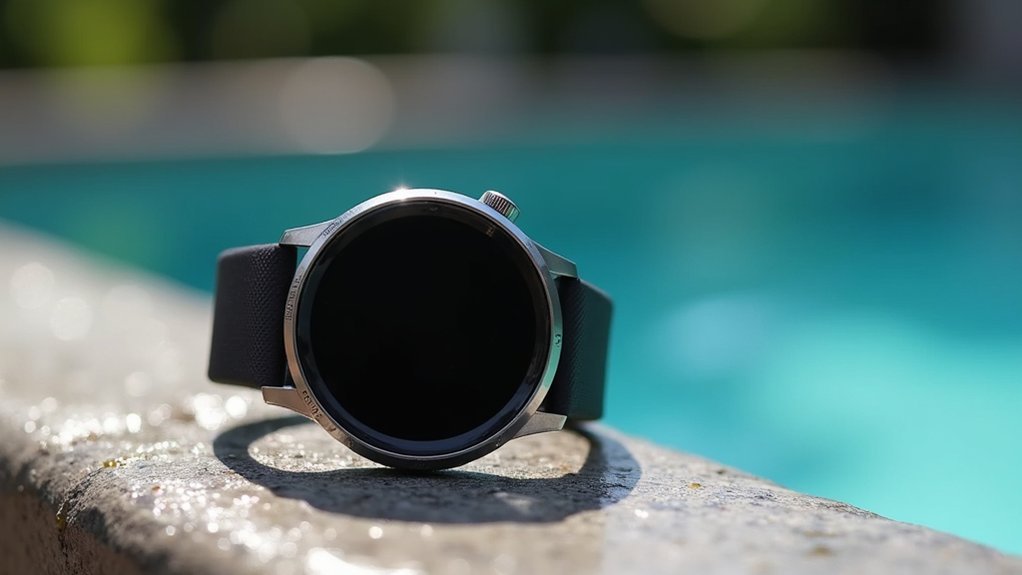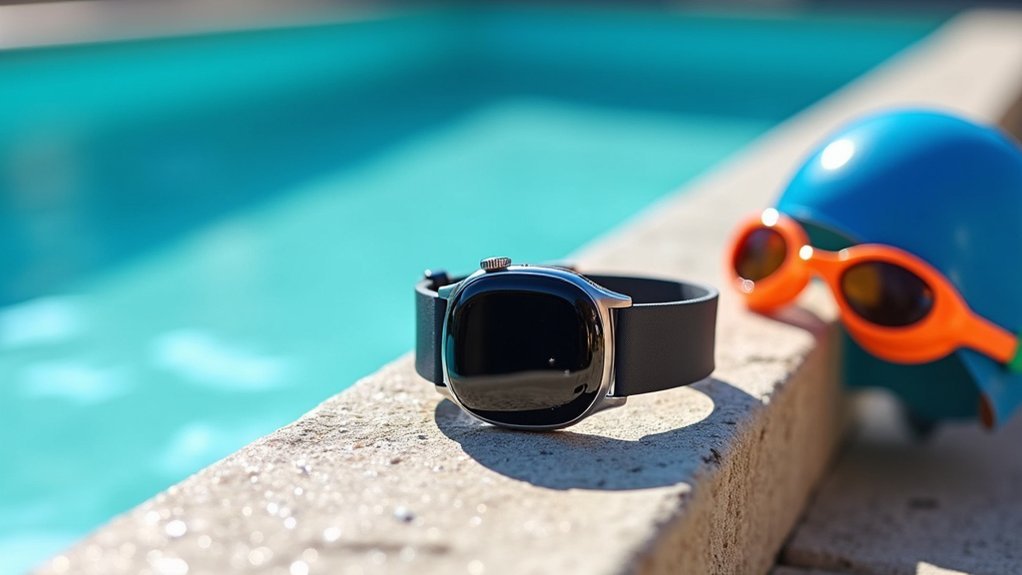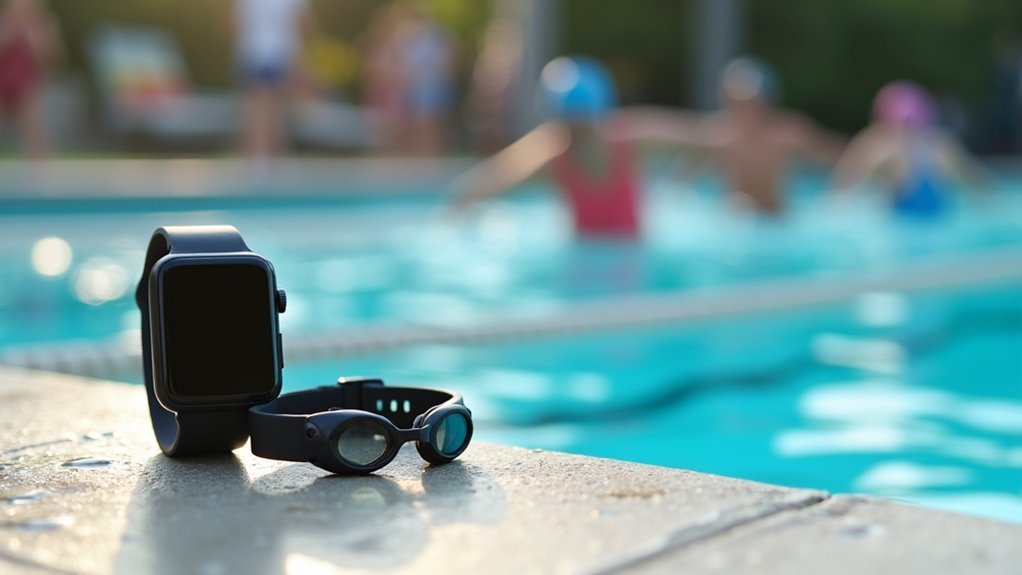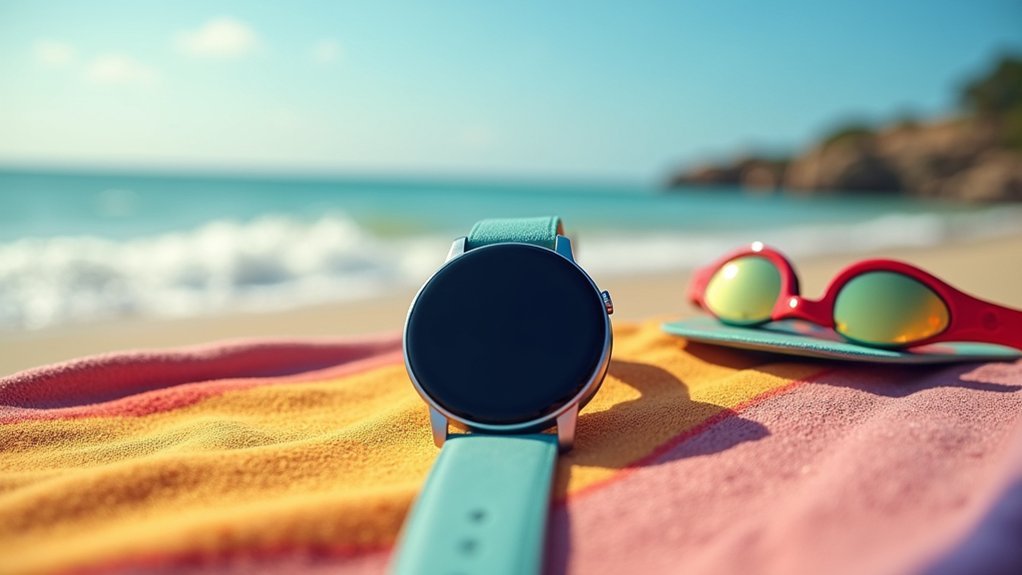When choosing a swim-ready watch, you’ll need at least 5 ATM water resistance for basic pool swimming, while serious swimmers should target 20 ATM ratings. Look for ISO 22810 certification for general swimming or ISO 6425 for professional diving activities. Trusted brands like Garmin, Apple, and Suunto offer reliable certifications that justify their higher costs compared to budget models without proper testing. Always verify independent laboratory testing and consider your specific aquatic activities when making your selection, as understanding these nuances will help you make the smartest investment.
Understanding Water Resistance Standards: ISO 22810 Vs ISO 6425

When you’re selecting a swim-ready watch, understanding the distinction between ISO 22810 and ISO 6425 standards becomes essential for making an informed decision.
ISO 22810 applies broadly to water-resistant watches, covering general water exposure without defining minimum depth requirements. It’s designed for consumer-level activities like swimming and showering, allowing manufacturers flexibility in testing methods and warranty conditions.
ISO 6425, however, targets professional dive watches exclusively. It establishes strict requirements including mandatory depth ratings and rigorous testing protocols.
Professional dive watches must meet ISO 6425’s demanding standards, including mandatory depth ratings and rigorous testing protocols for serious underwater use.
Every watch must withstand 125% of its rated depth pressure, plus additional tests for shock resistance, magnetic fields, and thermal shock. Only watches meeting these demanding standards can be labeled “Diver’s Watches,” ensuring they’re ready for serious underwater activities. These standards only apply to watches manufactured post-2010, as earlier timepieces were not subject to these uniform ISO requirements.
Evaluating Certification Bodies and Testing Requirements
Beyond understanding the standards themselves, you’ll need to evaluate which certification bodies actually test watches and what their requirements entail.
While USA Swimming and the United States Lifesaving Association focus on human certifications rather than product testing, specialized independent laboratories accredited for water resistance testing handle swim watch certification.
These testing labs evaluate watches through thorough requirements including water ingress protection at various depths, performance after chlorinated and saltwater exposure, and pressure resistance during dynamic movements.
They’ll assess your watch’s retention system to prevent loss during swimming and verify functional integrity of sensors under wet conditions.
Testing also covers material safety, ensuring finishes won’t harm your skin. Like the USA Swimming’s program that requires continuing education, watch certifications often mandate periodic retesting to maintain validity.
Third-party labs like Intertek perform these evaluations under international standards, providing the rigorous certification you need.
Matching Water Resistance Ratings to Your Swimming Activities

Once you’ve identified certified testing labs, you’ll need to decode the specific water resistance ratings to determine which watches actually match your swimming needs.
A 3 ATM rating only handles splashes and rain, not actual swimming. For basic pool swimming, you’ll want 5 ATM minimum, though extended submersion can compromise seals over time.
If you’re snorkeling or doing surface water sports, 10 ATM provides adequate protection against splashes, pool chemicals, and moderate pressure.
Serious swimmers engaging in high-impact activities should consider 20 ATM ratings, which handle recreational scuba diving and rigorous aquatic sports. Remember that water ingress can cause irreparable damage if protective seals fail during exposure.
Balancing Certification Costs With Quality Assurance
Water resistance ratings tell you what protection you’re getting, but certification costs directly impact what you’ll pay for that protection. ISO-certified watches cost more because manufacturers invest in rigorous lab testing and compliance fees, which get passed to you through higher retail prices.
You’ll find premium swim-ready watches almost always feature ISO certification, while budget models often skip it to keep costs down. This creates a trade-off: uncertified devices might save money upfront but risk failure in water environments, leading to warranty claims and replacements.
When choosing, compare certified and non-certified models within your budget. Look for a minimum 5ATM rating for safe submersion up to 50 meters when evaluating waterproof options. Prioritize certification for competitive swimming or open-water activities where risks are higher, and consider device longevity as quality assurance.
Identifying Reliable Brands and Their Swimming Watch Certifications

Brand reputation often matters more than flashy features when you’re investing in a swim-ready watch.
When choosing swim watches, prioritize established brands with proven water resistance over gimmicky features that may fail underwater.
You’ll find Garmin dominates the market with proven reliability—their Swim 2 and Fenix series consistently exceed 5ATM certification standards, with some models reaching 10ATM for deep-water activities.
Apple Watch Series 8/9 offers robust 5ATM rating with ISO 22810:2010 certification, supporting thorough stroke recognition and third-party swim apps.
Suunto earns praise from endurance swimmers and triathletes for accuracy and battery life, while Coros provides solid 5ATM performance at competitive prices.
Look for ISO 22810:2010 certification as your baseline—it’s the international standard ensuring your watch can handle pool and open-water swimming safely. Premium models also include SWOLF measurements to help you analyze your swimming efficiency and stroke technique.
Frequently Asked Questions
Can I Wear My Certified Swim Watch in a Hot Tub or Sauna?
You shouldn’t wear your certified swim watch in hot tubs or saunas. These environments exceed certification temperature limits, and heat plus chemicals can damage seals, cause fogging, and compromise your watch’s water resistance.
How Often Should I Have My Swim Watch Recertified or Tested?
You should test your swim watch before major events and update firmware regularly. For recreational use, check it annually. If you’re an official, recertification typically occurs every 18 months to 3 years.
Do Smartwatches Require Different Certifications Than Traditional Mechanical Swim Watches?
Yes, smartwatches use IPX ratings focusing on splash resistance and brief submersion, while mechanical swim watches require ISO 6425 certification for repeated diving use with pressure testing.
Will Saltwater Swimming Affect My Watch’s Certification or Water Resistance Over Time?
Yes, saltwater swimming will gradually degrade your watch’s water resistance. Salt crystals corrode seals and gaskets, compromising certification over time. You’ll need regular maintenance and thorough freshwater rinsing to preserve protection.
Can I Replace My Watch Band Without Affecting Its Water Resistance Certification?
You can replace your watch band without affecting water resistance if you follow manufacturer guidelines, guarantee proper sealing, inspect gaskets afterward, and have professionals test for leaks post-replacement.
In Summary
You’ve learned the essential factors for selecting swim-ready watches with proper certifications. Don’t compromise on ISO standards or testing requirements when you’re choosing your timepiece. Match the water resistance rating to your specific swimming activities, and balance certification costs with long-term quality. Research reliable brands that consistently deliver certified swimming watches. With these guidelines, you’ll confidently select a watch that’ll perform reliably in water while meeting your budget and activity needs.





Leave a Reply